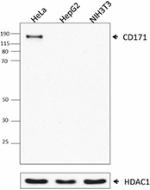- Clone
- L1-OV198.5 (See other available formats)
- Regulatory Status
- RUO
- Other Names
- CAML1, HSAS, HSAS1, MASA, MIC5, N-CAM-L1, N-CAML1, S10, SPG1, L1CAM, Neural cell adhesion molecule L1
- Isotype
- Mouse IgG2a, κ
- Barcode Sequence
- GATGGACGACAATTC
| Cat # | Size | Price | Quantity Check Availability | ||
|---|---|---|---|---|---|
| 371611 | 10 µg | $369.00 | |||
CD171, also known as L1CAM or L1, is a transmembrane glycoprotein. It is a 200-220 kD neuronal cell adhesion molecule and a member of the L1 protein family belonging to the immunoglobulin superfamily.
This cell adhesion molecule plays an important role in nervous system development, including neuron-neuron adhesion, signal transduction, axon guidance, cell migration and differentiation. CD171 also has a strong implication in treatment-resistanct cancers. Mutations in the gene cause three X-linked neurological syndromes known by the acronym CRASH (corpus callosum hypoplasia, retardation, aphasia, spastic paraplegia and hydrocephalus). Alternative splicing of a neuron-specific exon is thought to be functionally relevant.
Product Details
- Verified Reactivity
- Human
- Antibody Type
- Monoclonal
- Host Species
- Mouse
- Immunogen
- SKOV-3 ovarian carcinoma cells.
- Formulation
- Phosphate-buffered solution, pH 7.2, containing 0.09% sodium azide and EDTA
- Preparation
- The antibody was purified by chromatography and conjugated with TotalSeq™-C oligomer under optimal conditions.
- Concentration
- 0.5 mg/mL
- Storage & Handling
- The antibody solution should be stored undiluted between 2°C and 8°C. Do not freeze.
- Application
-
PG - Quality tested
- Recommended Usage
-
Each lot of this antibody is quality control tested by immunofluorescent staining with flow cytometric analysis and the oligomer sequence is confirmed by sequencing. TotalSeq™-C antibodies are compatible with 10x Genomics Chromium Single Cell Immune Profiling Solution.
To maximize performance, it is strongly recommended that the reagent be titrated for each application, and that you centrifuge the antibody dilution before adding to the cells at 14,000xg at 2 - 8°C for 10 minutes. Carefully pipette out the liquid avoiding the bottom of the tube and add to the cell suspension. For Proteogenomics analysis, the suggested starting amount of this reagent for titration is ≤ 1.0 µg per million cells in 100 µL volume. Refer to the corresponding TotalSeq™ protocol for specific staining instructions.
Buyer is solely responsible for determining whether Buyer has all intellectual property rights that are necessary for Buyer's intended uses of the BioLegend TotalSeq™ products. For example, for any technology platform Buyer uses with TotalSeq™, it is Buyer's sole responsibility to determine whether it has all necessary third party intellectual property rights to use that platform and TotalSeq™ with that platform. - Additional Product Notes
-
TotalSeq™ reagents are designed to profile protein levels at a single cell level following an optimized protocol similar to the CITE-seq workflow. A compatible single cell device (e.g. 10x Genomics Chromium System and Reagents) and sequencer (e.g. Illumina analyzers) are required. Please contact technical support for more information, or visit biolegend.com/totalseq.
The barcode flanking sequences are CGGAGATGTGTATAAGAGACAGNNNNNNNNNN (PCR handle), and NNNNNNNNNCCCATATAAGA*A*A (capture sequence). N represents either randomly selected A, C, G, or T, and * indicates a phosphorothioated bond, to prevent nuclease degradation.
View more applications data for this product in our Scientific Poster Library. - RRID
-
AB_2936673 (BioLegend Cat. No. 371611)
Antigen Details
- Structure
- 200-220 kD. Several immunoglobulin-like domains and fibronectin-like repeats (type III), linked via a single transmembrane sequence to a conserved cytoplasmic domain.
- Distribution
-
Tetanus-toxin positive neurons, endothelial cells, certain epithelial cells, reticular fibroblasts, colon and breast carcinomas, colon melanoma, tumor cells of neuronal and mesothelial origin.
- Function
- Adhesion molecule. Homotypic and heterotypic cell-cell interaction in neuronal myelination, neurite outgrowth and regeneration. Axonal guidance, neuronal migration.
- Ligand/Receptor
- Homophilic interaction with itself and heterophilic binding to integrins, other cell adhesion molecules, extracellular matrix molecules.
- Cell Type
- Endothelial cells, Epithelial cells, Fibroblasts, Neurons
- Biology Area
- Cancer Biomarkers, Cell Adhesion, Cell Biology, Immunology, Neuroscience, Synaptic Biology
- Molecular Family
- Adhesion Molecules, CD Molecules
- Antigen References
-
1. Wolterink S, et al. 2010. Cancer Res. 70(6):2504.
2. Huszar M, et al. 2006. Human Pathology 37(8):1000.
3. Kaifi JT, et al. 2006. Anticancer Res. 26(2A):1167.
4. Kaifi JT, et al. 2006. Mod. Pathol. 3:399.
5. Meier F, et al. 2006. Int. J. Cancer 119(3)549.
6. Stoeck A, et al. 2006. Biochem. J. 393:609.
7. Gutwein P, et al. 2005. Clin. Cancer Res. 11(7)2492. - Gene ID
- 3897 View all products for this Gene ID
- UniProt
- View information about CD171 on UniProt.org
Other Formats
View All CD171 (L1CAM) Reagents Request Custom Conjugation| Description | Clone | Applications |
|---|---|---|
| Purified anti-human CD171 (L1CAM) | L1-OV198.5 | FC,ICC,WB,IHC-F,IHC-P |
| PE anti-human CD171 (L1CAM) | L1-OV198.5 | FC |
| Alexa Fluor® 647 anti-human CD171 (L1CAM) | L1-OV198.5 | FC,IHC-P |
| TotalSeq™-C0430 anti-human CD171 (L1CAM) | L1-OV198.5 | PG |
| TotalSeq™-B0430 anti-human CD171 (L1CAM) | L1-OV198.5 | PG |
Compare Data Across All Formats
This data display is provided for general comparisons between formats.
Your actual data may vary due to variations in samples, target cells, instruments and their settings, staining conditions, and other factors.
If you need assistance with selecting the best format contact our expert technical support team.
-
Purified anti-human CD171 (L1CAM)
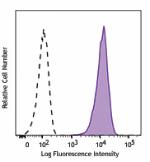
M21 cells were stained with purified CD171 (clone L1-OV198.5... 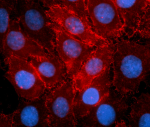
HeLa cells were fixed with 2% PFA for 10 minutes, permeabili... Total cell lysates (15 µg protein) from HeLa, HepG2 and NIH3... -
PE anti-human CD171 (L1CAM)
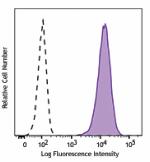
M21 cells were stained with CD171 (clone L1-OV198.5) PE (fil... -
Alexa Fluor® 647 anti-human CD171 (L1CAM)
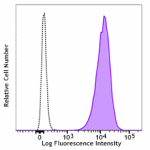
Human M21 cell line was stained with CD171 (clone L1-OV198.5... 
Human paraffin-embedded colon tissue slices were prepared wi... -
TotalSeq™-C0430 anti-human CD171 (L1CAM)
-
TotalSeq™-B0430 anti-human CD171 (L1CAM)

